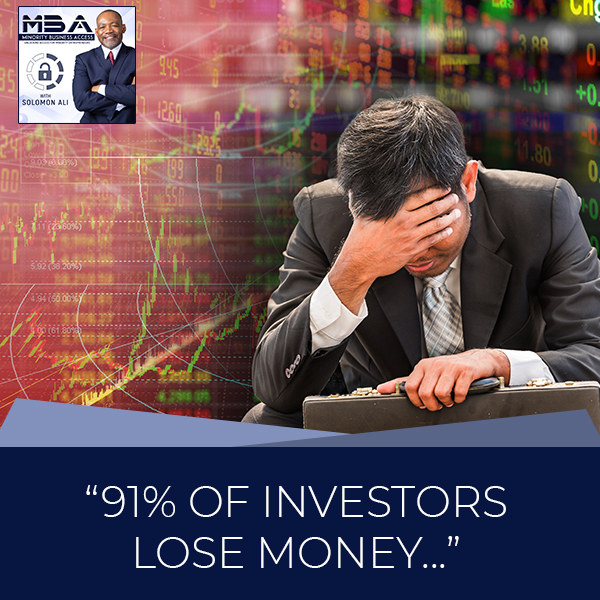
Playing to win with investing? Then keep your emotions out of the game. Billion-dollar Private Equity Investor, Solomon RC Ali, shares his Four Tenets of Good Investing to help entrepreneurs and investors side-step major financial losses by avoiding the pitfalls of emotional investing. He stresses the importance of creating your own road map, due diligence, and pulling from others who know more than you do. Solomon also reveals what the 9% who win at investing have learned that the 91% who lose money don’t yet know.
—
Watch the episode here
Listen to the podcast here
“91% Of Investors Lose Money…”
This year 2021, starting off, is a really exciting year. We’re only a few days actually into the year, but I want to go ahead. My team keeps finding these amazing pieces of information of other videos that’s already so well done. I can’t do it any justice. The best thing I can do is listen to my team to share this information with you, give you my opinions on it. That’s what we’re going to do. Thank you all so much for joining in on the show and taking a look at what we have because it will help you. Everyone, it will help you to navigate the fields and avoid those minefields. That much I can promise you because you won’t make the mistakes that I have made along the way that other entrepreneurs and business people have made along the way. You’ll be able to avoid some of that and get to your destination a lot sooner. We’re going to watch the first video and we’re going to pause it as we’re going.
Become Part Of The 9%
“I’ve got a great webinar called Become Part of the 9% and on 91% Losing Spread Betting. There are many things you would need to do to become part of the 9%. If it were that easy, everyone would be part of it. There are a lot of intelligent people making a part of the 91%. In fact, you will always vacillate. You will be in the top one and occasionally will be outside the 9%. What you need to do is you need to potentially decide on a strategy that looks after all elements of money management. We’ve discussed the risk-reward and the losses. You’ve got to manage losses that keep you in the game. You’ve to believe you have a system that will make more than it gives back on its winning.”
You don’t get there. When we say a system, we’re talking about a roadmap. You have to develop a roadmap. A lot of times, that roadmap is not going to come from your own creation. It may be your initial idea and concept, but you have to pull information from other people who know a lot more than you to develop the roadmap. It’s like when you’re building a house, you’ve got your general contractor, but then he brings in the different trades. The different trade people come in, and one might be the plumber, one might be the one framing the house, laying the concrete or the floor, putting on the roof. You have all the different trades in there. In the end, it’s a house. Think of yourself as the contractor that has to bring in all of these experts in to help you to finish your tasks to get to where you’re going. Your task is you’re looking to make better trades and better investment. What do I keep saying? You keep hearing me. If you’re reading this, you’ll know this. Look at the management team. Does the company have the potential of a triple-digit growth? Is it in the right industry? Is the company reinvesting its money to grow itself? Those are very critical things that when you’re making an investment into a company, that’s going to depict your returns.

Investors Lose Money: Money normally follows money.
If that company is missing any one of those things within your formula, you’re going to have lousy returns, or basically you’re playing a game of chance. This is a way to eliminate the game of chance. It’s not 100% all the time. Sometimes it’s going to miss because that’s life, things happen. For the majority of the time, if you’re following those kinds of principles right there, you’re going to win. The other thing is that people always forget that there is a thing called ‘pay your dues,’ which is taxes. You must always equate that into your equation. When people would say, “I’ve got 50%, 200%, 300% return,” what does that mean? When I look at it, I’m like, “Okay.” After you pay taxes, you didn’t get as much as you thought. Where if you would have held on to it for a year and one day, it may arise up and down, but when you count in the tax benefit, you may end up with a much higher return. Those are the things that you’ve got to be looking at.
The other thing is I’m going to keep saying this, there are companies out there who are doing the due diligence, the research, pay the money to spend to get these analysts’ reports, to get an understanding of the company, the industry, the management, what’s going on. Not only that, there are companies out there who are loaning money to these companies. If they’re loaning money, don’t you think that might be probably a good probability that they believe in the company and they have a reason to believe in the company? They have more resources than you do, so they can take their resources and do all of this work behind the scenes to figure out what’s going on with that company before they invest their money. If Warren Buffett invests money in a particular company and I’m interested in that industry, I’m going to invest over there as well. It’s that simple. Money normally follows money. If I’m watching other people invest in things as wealthier than not, I might have to go invest in that and do that too. I know they’ve done some type of research. I know they didn’t throw it to chance. I don’t follow people I don’t know understand. I don’t recommend you to do that neither. If you have any questions, look up SolomonRCAli.info. Go there and you can see what we’re doing, the research that we do on companies, educational purpose. I am not telling you to invest in anything, that’s up to you and the companies that you find. It gives you a good concrete idea of how to go about it, so that you will end up on the top end and not in that 91%.
Invest Long-Term
“The time no one is ever going to have 100%, except that losses are part of the game and manage that. Become as systemic as possible in determining what your setup is. The more it can be reduced to a logic, the better and the tighter. You need to stick to the system systemically as possible as well, which most people are incapable of with emotions, particularly after three losses. You’ll be snakebite fearful. After three wins, you’ll be piling on twice the size. That will be the one that loses, and give back all of those three wins and some. That’s where focusing is on. If you had to develop a black box system, it’s not a bad process for defining your strategy and that which you find interesting. Observing charts, a lot of observation, a lot of drawing of charts and a lot of use of patterns.”
You should not be investing in anything that you’re not willing to hold long-term.
A lot of you turn around, you’re in a stock, and all of a sudden the stock is going down. You get emotional and you see everyone fleeing. You might even read a PR and all of a sudden everyone’s fleeing. I like what Warren Buffett says, “When everyone’s leaving, that’s probably the time to be buying.” That’s what I do. If everyone’s jumping out, I’m not jumping out because everyone else is jumping out. I am probably going to accumulate more because one of the greatest investors that this country has said that when everybody leaves, you should be going in and buying them. When everyone is buying, you should probably be leaving.
The other thing that most people make is very common, and I did it also in my early days. In fact, I did it with Facebook. It hit a number. When I say, “I got in somewhere between $7 and $9, around 38 are sold.” It was too early to sell. Within probably about the first six months or so, I took my money off the table. That means I paid the short-term capital gains tax on that. Here’s my point. When you invest, think long-term. You should not be investing in anything that you’re not willing to hold long-term. Long-term is not 90 days. In fact, long-term is well over a year. You should be willing to hold that investment because that investment is going to go up and down. There are going to be some bad decisions by management from time to time. There’s going to be some panic selling. There are going to be some analysts giving predictions and things of that nature based on their due diligence and investigation that don’t match up.
People are prone to be wrong. You stay long-term and it allows everything to settle, and that’s what you’re looking for. You’ve got to know that when you go in, “I’m going in here long-term. I don’t mind holding this stock for 3, 4 years if I have to.” It’s great because I like the industry, the management, the company. I see the things that they’re trying to do. They’re solving problems for other people. You got to have the fundamentals down of knowing what drives a company and what drives their revenue? What drives the industry? What makes them disruptive in the industry? What is it that they’re bringing new? When you know and understand those things, you can do this. Sit back with confidence in your stock picks. That’s what’s important.
When you see the stock or some bad news coming out, you’re not freaking out. You’re like, “Let me buy some more.” Then what happens is you start averaging. At that time that you’re averaging when the stock price starts to make its gains, they don’t even at that point have to be significant gains when they start making gains again, all of a sudden because you have average, your returns begin to become greater. Most of the time, even greater than it would have been before. Let’s go back to the video and I’m going to try to be quiet because he’s really good. He knows what he’s talking about.

Investors Lose Money: To get off of that emotional roller coaster, know what it is that you’re investing in.
Emotional Investing
“Patterns are probably the most powerful technical analysis tool for me outside of the larger trend of Dow Theory. Most of the trading mistakes made by beginners, even intermediate and occasionally even advanced people when they lose their heads is to do with trade sizing. They take a loss too big. There’s no damage done in taking your managed loss. That’s part of the game in being wrong. The problem is that recovery ladder when you then emotionally, negatively respond to taking an already slightly bigger loss. Let’s say you lose 15% or 20% and then you think, “I want to get back to where I was. I need to make 25%. I’ll trade bigger again. I’m sure I’m right this time.” You can’t cope with the mental cognitive dissonance that makes you need to get back to where you once were because you’re now seeing yourself as the lesser self as dictated by this balance.”
He’s talking directly to traders, but I need to break this down for you. The reason people get emotional and they say, “I bought the stock. It was at $15 and now it’s at $17, $15, $8.” The reason they get emotional and panic is because of one simple thing. They bought the stock on emotion. They bought the stock thinking it was going to rise. They didn’t know anything about the stock and the management team. They didn’t have the basics that they needed to know to make an informed decision. You must make an informed decision. That’s critically important, know the company, know the industry, know what they’re doing, know why they’re doing it. It’s critical. Otherwise, you’re going to be an emotional roller coaster. The stock goes up, you’re happy. The stock goes down, you are sad and depressed. The stock goes up, you’re thrilled. The stock goes down, you’re sad.
To get off of that emotional roller coaster, know what it is that you’re investing in. Be excited about, “This industry is new, it’s growing, exciting. This company looks like it’s going to be a disruptor. The company is adding new value where I see the first top five companies in the industry are not doing anymore. Management has got a proven track record in growing and scaling a business and things like that. They’re reinvesting their money back into the company for its company’s growth and success.” There are going to be some ups and downs. When you understand what it is that you have invested in, you can hold your position. We’re freaking confident because you know what it is that you were investing in. You’re not looking at the stock price, “It’s up, it’s down.” I don’t look at stock prices every day. I look at the companies that I invested in. Once I’ve invested in it, I’m done. I’m riding it out. I’m in for the win.
I already know that they’re going to win because I’m confident in the research and what I’ve invested in. The research that’s been gathered, that’s exciting. That’s when you know. That’s what the investors do. Otherwise, you’re going to be one of these people jumping off the building because the damn thing went plummet. If they plummet, I’m not worried about it. I’m like, “I better pick up some more before everybody else catches on,” to what I know based on what the research has revealed. Sometimes like in life, when we start things out, just because it’s supposed to work a certain way, doesn’t necessarily mean it’s going to work out great. There are going to be some up and downs.
If you follow what we’re teaching on the show, when you make a mistake, here’s what you will not do. You will not get emotional and start selling or dumping. You won’t get emotional and start average when you shouldn’t be averaging. You’ll be able to stand your ground because you know that your due diligence that has been provided to you is rock solid. You know that you’re standing on a solid foundation. You’ll be able to hold your possession with confidence. That’s basically what happens when you make an investment and you’re throwing caution to the wind. You don’t know much about the company. You’re just looking at the stock. Everybody’s talking about how hard it is. All of a sudden, the stock or whatever starts going down, then you decide to hit for the doors.
If you know the company, you understand what it is that you’re investing in, and you stick to your core principles that you’re learning, you will be able to hold that possession. You won’t be selling and dumping, taking huge losses like everyone. You won’t be going in, averaging and losing money because you’re averaging at the wrong time. You’ll understand what’s taking place. Don’t get me wrong, I believe when the stock drops in price, I believe in averaging. I only do that in the companies that I know, that I understand, that I know what’s happening in the industry and in the company. Make sure you understand this. We’re going to get back to the video because he’s sharing some good stuff, especially for those who like to trade stocks all the time. This is really good stuff.
The first bad decision you will make is buying a stock that you did not understand.
Understand Your Stocks Before Investing
“You now see yourself as the lesser self as dictated by this balance, and that then pressurizes you into trading bigger again on what looks like a sure thing. You punch drunk because you must find an opportunity quickly, and it’s not a sure thing. It’s the first thing you grabbed hold of that best represents a possible trade. You’re then bastardizing your criteria to grab hold of something that you expect to leverage you back into where you once were. This is a very big fatal spiral because once again, you then overtrade because you’ve got to make back more to get back up. That’s the recovery ladder concept and that is probably the single most destructive that sees someone have a £10,000 account reduced to a few hundred or £1,000, and then virtually giving up, realizing that they’ve blown it in size.
I wouldn’t say 91% are in that category. They don’t all blow their accounts up from £10,000 down to £9,000, but they’re on possibly consistent with money management as a whole. Sizing is one element of money management. Don’t forget I said risk reward should be central to that as well. They’re taking trades that aren’t worth the squeeze, the juice isn’t worth the squeeze. The probability of win rates they haven’t tested, what likelihood are they of winning? It’s too tight to stop something else I’ve mentioned. All of those things fall under the larger money management cluster. Those are all key.”
“Do you agree with this statement? “The only way to make money is slowly and steadily over time.”
“No, I wouldn’t agree with that statement at all. Those underlying markets can be traded profitably on a consistent basis. There isn’t an efficient market hypothesis that truly keeps everything at true value. Anything that involves people will have reactions, over-reactions and under-reactions. I think I wouldn’t be in the game if I didn’t feel that there was an edge that could be taken.”
Is it the right management team? What are they doing? Do they have a track record? Are they reinvesting their money back into their company for growth? You’ve got to know these things. Other investors coming in, institutional investors, things like that coming in, these things are critical. Does the company have an opportunity for double-digit or triple-digit growth? I like triple-digit growth. If that’s my model, if I see something with double-digit growth, it doesn’t fit the model. I’m not doing it, that doesn’t work for me. Before I invest in another stock, I’m going to play that rule back to myself and wait, stop, hold, whatever you want to call it. I’m going to reveal those rules, and then I’m going to see the next stock, “Does it make those particular rules?” If it does, then I move forward with an investment in that company.
You’re not going to get every last one of them right, but you’ll get the majority of them right. The majority of them, they’ll be right. Your big ones, you’re probably only going to get 3 or 4 that’s going to win and hit it out the park for you. They’re also going to take your overall average portfolio way over the top. Let’s keep that in mind. That’s what he’s talking about. When you make a bad decision, your first bad decision was you bought a stock, you didn’t understand it or anything about the company or the industry and things of that nature that stopped and did something that you weren’t expecting. You dumped out of the stock, which was your second bad decision is that you jumped out of the stock. You bailed on it for whatever reason, negative press release, everybody starts selling, or it dropped below a certain threshold point that you may have had set. I don’t know how you can set a threshold up or down if you didn’t do the basics and the first.
If you’ve got a rocky foundation, the whole thing stays rocky. You’ve got to do the first things first. If you had done that, then you’ll know, “It’s going through something. I know the accumulate average a little bit more. I don’t have to panic.” You’ll only know to do that when you know the company, the industry, the management. The management is reinvesting in the company. The company has the potential for triple-digit growth. That’s when you know, “It doesn’t matter what the stock is doing. I’m not looking at the stock. I’m looking at what’s going to happen.” It’s very important.
I hope we’ve been able to bring you some value and sharing the information that we have shared with you. My team’s doing a good job going out and getting other information for you to take a look at, to give you a more diversified and a more round view of what it is that we look at, how we look at it. We’re excited. If you have any questions or anything of that nature or want to learn more, reach out to my team at SolomonRCAli.info. Don’t forget, I got a book coming out in 2021. You could read the book. It will guide you through all the minefields and help you to get to the other side, so that you can do and figure that out for yourself what is best for you, so you will have your own winning strategy. Thank you so much for tuning in to the show. See you soon.

